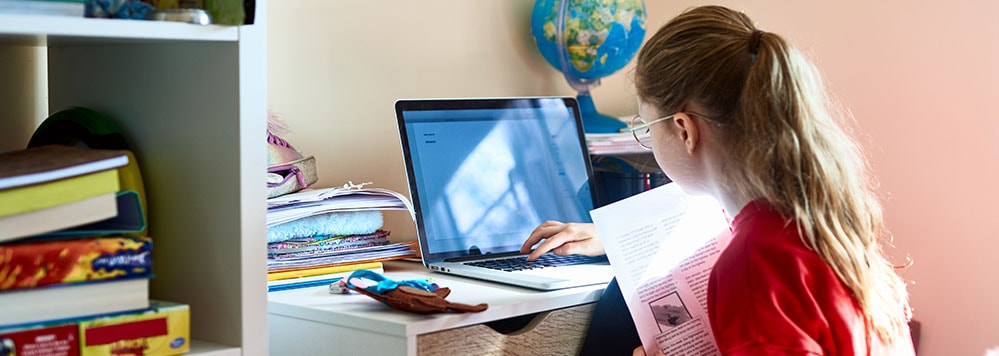COVID-19 is forcing learning to change at warp speed. Educators, students and parents are all digging deep and finding the resilience they need to rise to the occasion. But even when students return to the classroom - the technological leaps taken with artificial intelligence in learning will remain. COVID-19 may be just the push educational institutions need to morph into a live enterprise.
Learning has changed overnight. COVID-19 has made everyone an e-learner. Teachers, students, and even parents are learning and working online every day. E-learning itself is nothing new. It’s a successful and rapidly growing market, forecast (before the COVID-19 pandemic hit) to grow to $300 billion by 2025.1 But its mainstay is adult education, corporate training, and specialty courses — not primary and secondary education.
Resilience is important for educators now as there are many challenges and quirks to work through. But very quickly, online access to classes will become the new normal, and it will open a gateway for three big changes in the delivery of online and traditional learning.
Mass-market education
The e-learning market will be transformed by the entrance of millions of primary and secondary students and teachers going online. The internet enables students and teachers to expand their horizons and permits them to look elsewhere for better instruction, or more opportunities to teach.
Students and parents will increasingly access alternative or improved content and teaching from outside their specific school. No longer do students have to be limited by that teacher they don’t get along with. And given that e-learning supports cheap, bite-sized, and sometimes free learning — this could mean that many students get a better quality of education. Or at least one more suited to their learning style.
E-learning can provide a better quality of education at an affordable price
But teachers too have the same opportunity. In just a few weeks, millions of teachers had to learn the skills to become full-time e-learning instructors. Many teachers will get good at recording lessons for their students and posting them on YouTube or other paid-for learning platforms.
“YouTuber” is not a profession most teachers would have aspired to before COVID-19, but we should expect many to emerge from this period as bona fide YouTube stars. Take Joe Wicks, the fitness instructor who has become the world’s PE teacher. Millions of people stuck at home during lockdowns watch PE Joe’s child-friendly workouts, which he livestreams every weekday morning.
Long term, we can expect to see a much more active market for teaching online at primary and secondary schools. And we will see a significant democratization in learning at the primary and secondary levels. By the end of 2020, the amount of quality teaching content online will have grown exponentially, and could be marketed to students from all over the world. The business model and method for teaching and achieving educational impact could significantly change in light of this opportunity.
Artificial intelligence support
Whether online or off, most teachers struggle to spend enough time with each of their students. Teachers often spend up to 50% of their time on back-office responsibilities, such as grading exams, managing classroom materials, planning field trips, dealing with absent students, and responding to parents. Technology, namely AI, can help. And while to date it has seemed farfetched to incorporate AI in the physical classroom, it can be used online seamlessly to help improve e-learning outcomes. Once lockdowns end, AI could be brought back to the physical classroom as well.
AI builds a learning profile through machine learning that automatically reviews students’ submissions, interactions, and performances. It can recommend specific learning content or pathways for individual students. This helps students fill in knowledge gaps that teachers might miss on their own. Each student’s learning plan can be tailored to his or her learning style, which can help the student learn at a faster pace.
A plan tailored to a student’s learning style can increase learning speed
It can also help once the content has been completed. A startup company called Bakpax can automatically grade student work and give learners immediate feedback. Students simply take a picture of their finished assignment and submit it. Teachers can see which topics are easy for a student and where they are struggling, according to the company.
On a larger scale, this data and insight can also begin to inform education strategy at the district level. By tracking performance and continuously learning from interactions with students, AI can be used to help update regional curriculums. It could also help identify groups of students with special requirements for further public investment.
But perhaps more exciting is that AI can help teaching reach further than ever thought possible. Not only could it help teachers with ever-growing class sizes — most obviously through the use of chatbots to help field questions from students — but also it could enable teachers to go global. Language barriers are no longer a problem. Already, students can take a class from a teacher who speaks a different language by using a free plug-in for PowerPoint called Presentation Translator. The app creates real-time subtitles while the teacher speaks. This technology can also help students with a hearing impairment and open a world of learning to students far beyond what is available at their particular school.
AI and virtual technologies are already in many homes helping with learning today. Amazon’s Alexa can help with math skills, spelling, act as a dictionary/thesaurus, and answer research questions. There are also learning skills parents can add to their Alexa – like spelling bee, 1-2-3 math, animal workout, curiosity, daily dinosaur, this day in history, etc.
Moving beyond the voice, augmented and virtual reality are helping students learn around the world. In China, nearly 200 million primary and secondary students can choose from 22 online course platforms, most of which are empowered by artificial intelligence. In Italy, virtual reality is improving the way people learn English as a foreign language. They’re using Rumii, which is a social virtual reality space where students can collaborate and communicate as if they’re all in the same physical location.
In person versus online
In this new world, private schools, colleges, and universities will have to prove why students should keep paying more to attend a physical school rather than the online version.
As unemployment soars, it will become more difficult for parents and/or students to pay college tuition. An affordable online school will certainly become more appealing. As more schools offer this option, this will pressure expensive face-to-face educators to prove the additional value they add through proximity.
Harvard Business School is one example of the increasing respect given to online degrees. In January 2019, Harvard Business School changed the name of its online learning platform from HBX to Harvard Business School Online. The name change shows just how respected online education is now. The argument can be made that not having an online degree could hurt a school’s reputation — making them look as though they’re not actively engaged in the online learning space.
While not an Ivy League school like Harvard, the University of Arizona is a well-respected school that illustrates the savings of online versus an on-campus degree. As illustrated in Figure 1, U of A tuition will cost Arizona residents $12,600, out-of-state residents $36,600 and online students $6,000 for the 2020-2021 school year.
The University of Arizona offers 200 online degrees, which provide the same curriculum and classes taken by on-campus students, but the cost to attend online is significantly less. The online tuition price is the same for everyone, whether they live in Arizona or not. Sure, students will miss the experience of living in a tiny dorm room with someone they’ve never met and attending a few fraternity parties, but the savings make a college degree a possibility for some who otherwise could not afford one. And this bargain of a degree will look no different on a resume than the full-price degree earned on campus.
Figure 1: Wide variation in tuition for the same degree

Become a live enterprise
Maybe the most important lesson for all of us in these uncertain times is learning how to change and adapt. For teachers, this is a time to use technology to make their jobs easier, whether they’re teaching from home or in the classroom. They can learn to teach their best lessons on YouTube and maybe even become a star in the process.
This period of unexpected closure and forced e-learning is an opportunity for schools to get comfortable with technology. Of course, security and data privacy will also have to come to the forefront of how schools manage their online students as this becomes the new norm – something that most institutions will not have had to think about at this scale. But, rather than looking at this change as a negative, school administrators need to see this as a chance to keep investing in new models — including AI.
The idea is to turn an educational institution into a live enterprise
It’s the right time for every educational institution to become a live enterprise. Schools can build knowledge graphs by using AI to sense each student’s experience and learning patterns. The knowledge base and AI can be used together to customize the teaching method, content, instructor, and the learning path itself. The idea is to create a sentient educational institution, or live enterprise, that can sense, process, and react. This will completely change the education industry by helping schools behave like a living organism that is completely digital, responds with agility, and gives a seamless experience to its key stakeholders — students, teachers, and parents. Investment in online learning will not be wasted when COVID-19 is history. In the future, schools will need an online footprint to be taken seriously.
References
- E-Learning Climbing to $325 Billion by 2025 UF Canvas Absorb Schoology Moodle, TJ McCue, July 31, 2018, Forbes





